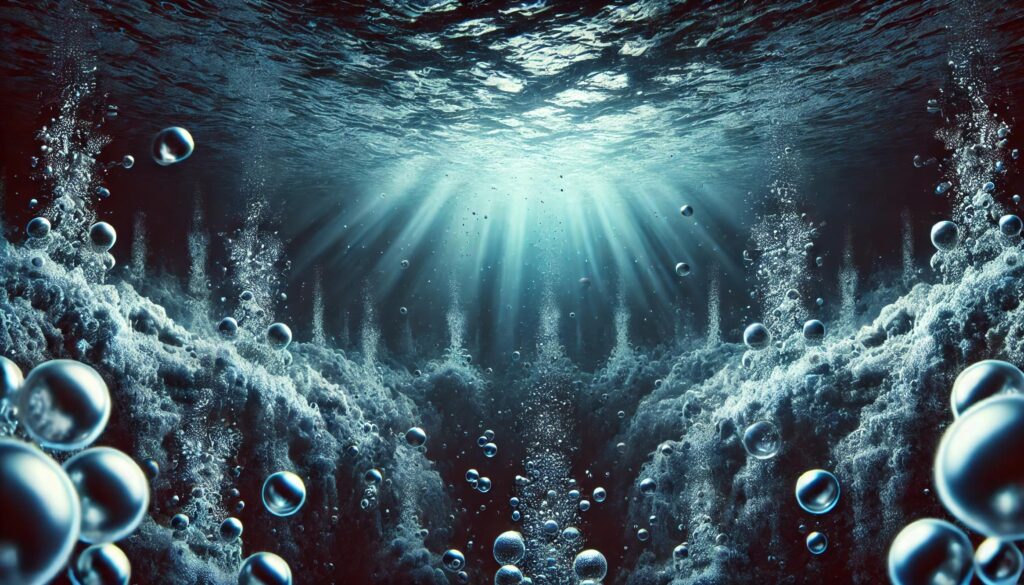A new carbon capture technology developed by the University of Texas at Austin speeds up the conversion of atmospheric carbon dioxide into hydrates for ocean storage, offering a safer and more efficient alternative to injecting it into underground reservoirs. Credit: SciTechDaily.com
Researchers have developed a new method of carbon storage that promotes the formation of carbon dioxide hydrates using a chemical-free process.
The technique involves converting carbon dioxide into a stable, ice-like substance that is then buried in the ocean, potentially drastically reducing atmospheric carbon levels and combating climate change more effectively than traditional methods.
A new method for capturing carbon from the atmosphere and storing it, developed by researchers at the University of Texas at Austin, doesn’t require harmful chemical accelerants and works much faster than current methods.
In a new study published today (July 8) in ACS Sustainable Chemistry & Engineering, a team of researchers developed a technique to produce carbon dioxide hydrate extremely fast, a unique ice-like material that could bury carbon dioxide in the ocean and prevent it from being released into the atmosphere.
Infrastructure for this new carbon storage technology. Credit: University of Texas at Austin
Innovative Carbon Storage Technologies
“We face a major challenge in finding ways to safely remove gigatons of carbon from the atmosphere, and hydrates offer a universal solution for carbon storage. For hydrates to become a major part of carbon storage, we need technologies to grow them rapidly and at large scale,” said Vaibhav Bahadur, a professor in the Walker College Department of Mechanical Engineering, who led the study. “We have demonstrated that hydrates can be grown rapidly without the use of any chemicals that would offset the environmental benefits of carbon capture.”
Carbon dioxide is the most common greenhouse gas and the main cause of climate change. Carbon capture and sequestration removes carbon from the atmosphere and stores it permanently, and is considered a key element in decarbonizing the planet.
Carbon capture hydrate created in Vaibhav Bahadur’s lab. Courtesy of the University of Texas at Austin.
Addressing the challenges of current carbon storage methods
Currently, the most common carbon storage method is injecting carbon dioxide into underground reservoirs, a technique that has the advantage of both trapping carbon and increasing oil production.
However, the technology faces significant challenges, including carbon dioxide leakage and migration, groundwater contamination, and seismic risks associated with injection, and many parts of the world lack suitable geological features for reservoir injection.
A close-up of the new carbon storage hydrate. Courtesy of the University of Texas at Austin.
Breakthrough in Hydrate Formation for Carbon Storage
Bahadur said hydrates are “Plan B” for large-scale carbon storage, but could become “Plan A” if some key problems can be overcome. Until now, the process of forming carbon-trapping hydrates has been slow and energy-intensive, making them unsuitable for large-scale carbon storage.
In the new study, the researchers were able to increase the rate at which hydrates form by six times compared to traditional methods. This speed, combined with a chemical-free process, makes these hydrates more likely to be used for large-scale carbon storage.
Implications and Future Applications
Magnesium is the “secret sauce” in this research, acting as a catalyst to eliminate the need for chemical accelerators. This is facilitated by bubbling CO2 at high flow rates through a specific reactor configuration. The technology works well with seawater and does not rely on complex desalination processes to produce fresh water, making it easy to implement.
“Hydrates are an attractive carbon storage option because the ocean floor provides stable thermodynamic conditions and hydrates do not break down,” Bahadur said. “We are essentially making carbon storage available to every country on Earth that has a coastline, making storage more accessible and feasible on a global scale, bringing us closer to achieving a sustainable future.”
This breakthrough goes beyond carbon sequestration: ultrafast hydrate formation has potential applications in desalination, gas separation and gas storage, providing a versatile solution for a range of industries.
The researchers and the University of Texas have applied for two patents related to the technology, and the team is considering a startup to commercialize the technology.
Reference: “Ultrafast Formation of Carbon Dioxide Hydrate Foam for Carbon Sequestration,” by Awan Bhati, Mark Hamalian, Palash V. Acharya, and Vaibhav Bahadur, July 8, 2024, ACS Sustainable Chemistry & Engineering.
DOI: 10.1021/acssuschemeng.4c03809

